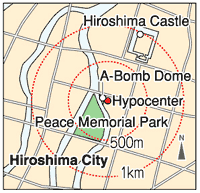(43)What impact did the atomic bomb have on trees?
I have heard about "A-bombed trees" but how exactly were trees affected by the atomic bomb?
Impact can be seen within a radius of 1 kilometer of the explosion
Preservation activities involving A-bombed trees are often reported in the newspaper and on TV. The existence of these trees is widely known both in and outside Japan as seeds of an A-bombed paulownia tree in Hiroshima Peace Memorial Park have been shared with the world. Offspring of this tree are now growing in other countries.
When the atomic bomb exploded, trees, as well as human beings, were exposed to the blast, heat, and radiation.

A report on the damage caused by the atomic bombing, issued in 1953, describes the bomb's impact on trees and plants, by area: 0~50 meters from the hypocenter, 50~500 meters, 500~1,000 meters, etc. The report reads: "Deformities and abnormalities are seen in most trees and plants within the bombed area. ... These effects are found within a radius of 1 kilometer of the explosion, but are seldom seen outside this distance." In short, within 1 kilometer of the hypocenter, there was some impact on trees and plants.
Within the report is a section titled "The impact of radiation, mainly concerning plants," which outlines the results of an investigation in the field which took place over ten days from September 21, 1945. "Though the existence of further deformities in outlying areas could not be confirmed," it reads, "the only ones found existed within 1 kilometer of the hypocenter."
Trees are resistant to radiation
The key seems to be the radius of 1 kilometer. Compared to the impact on human beings, though, the area of impact on vegetation appears much smaller.
I spoke with Mitsuru Nishiguchi, chief researcher at The Forestry and Forest Products Research Institute in Ibaraki Prefecture and a specialist in molecular biology. His organization has been investigating the impact of gamma rays on poplar trees.
"Trees are generally very resistant to radiation," he said. "Human beings may die when exposed to 7 Gy of radiation, but even 50 Gy can have little impact on poplar trees."
However, the effect of radiation on trees also depends on the type of tree and its stage of growth. "Conifer trees, like the pine, are relatively weaker species. After Chernobyl disaster, European red pine trees in the area withered and died from exposure to more than 60 Gy. One report suggested that only about 1 Gy of exposure resulted in temporary damage to tree growth."
In Hiroshima, to what extent did the atomic bomb cause damage to the trees?
An inspiration during reconstruction
According to a formula designed to estimate the amount of radiation that A-bomb survivors were exposed to, the point which measured about 1 Gy, an amount that damaged pine trees near Chernobyl, was 1.3 kilometers from the hypocenter. A level of 1.19 Gy was recorded at this spot in the aftermath of the atomic bombing.
The dispersal of radiation in Hiroshima was different from Mr. Nishiguchi's research or the Chernobyl disaster, but the report of damage to the city suggests that the amount of radiation within 1 kilometer of the hypocenter was a contributing factor in the damage done to vegetation. Mr. Nishiguchi points out, though, that the close proximity to the hypocenter means that "more of the environmental damage may have been caused by the blast and heat."
On the other hand, Professor Masaharu Hoshi of Hiroshima University Research Institute of Radiation Biology and Medicine believes that "about 1 Gy of radiation was also emitted in areas where black rain fell," basing this figure on findings at Semipalatinsk, the former Soviet nuclear test site.
The A-bombed tree located closest to the hypocenter is a willow about 370 meters away. Its trunk was blown down by the atomic bomb, but its roots survived and managed to grow again. Chikara Horiguchi, 63, a tree surgeon, has been engaged in the preservation of A-bombed trees for about 20 years. He is devoted to caring for the trees, saying, "The trees that survived the bombing were an inspiration during the reconstruction of the city. Even when the A-bomb survivors have all passed away, I hope the trees will continue to convey the reality of the bombing." (Toshiko Bajo, Staff Writer)
- A-bombed tree
Trees which survived the atomic bombing within a radius of about 2 kilometers of the explosion. The city of Hiroshima began to register these trees in 1996 and there are now about 160 in 55 locations. Trees situated on private property where citizens are not free to enter are not registered.
- Gray (Gy)
A unit for measuring the amount of energy absorbed by human beings and other living things as a result of radiation exposure.
- Chernobyl disaster
In April 1986, a nuclear reactor at the Chernobyl nuclear power plant, a facility of the former Soviet Union, exploded and caught fire. A large amount of radioactive material was scattered into the air and contaminated a wide area of Europe.